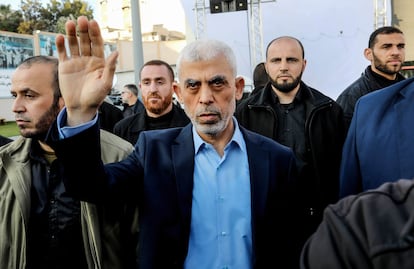Mohamed Deif and Yahya Sinwar, the masterminds of the Hamas attack who top Israel’s most wanted list
The intelligence services are pursuing the military and political leaders of the militia, while keeping the movement’s senior political figure, Ismail Haniyeh, in exile in Qatar, in their sights


There will be no prisoners among the Hamas leadership. Israel’s intelligence services have been attempting for 11 days to hunt down the leaders of the Islamist movement, who a military spokesman has described as “dead men walking.” Mohamed Deif — the faceless military commander of the Izz ad-Din al-Qassam Brigades, hidden in the shadows and who has escaped death a dozen times, most recently in 2021 — is considered the mastermind of the surprise attack launched on October 7, the deadliest since the 1973 Yom Kippur war between Israel and an Arab coalition led by Egypt and Syria. Israeli intelligence also wants the head of Yahya Sinwar, the political leader of Hamas in the Gaza strip, who spent 23 years in Israeli prisons. From his exile in Qatar, the chairman of the Hamas Political Bureau, Ismail Haniyeh, knows that he is also in the crosshairs.
At the height of the 2014 war, an Israeli airstrike targeting Deif’s home in Gaza resulted in the death of his wife and one of his young sons. Born in 1965 in the Khan Younis refugee camp in the south of the Palestinian enclave (as was Sinwar), the head of Hamas’ military arm, whose real surname is Masri, has remained top of Israel’s most wanted list since the end of the First Intifada (1987-1993). The Israeli army’s elite commandos and the Shin Bet internal security service have had Deif in their sights several times, but he has always managed to escape attempts on his life, although badly wounded, launched by missile attacks on his cars or his safe houses.
Deif never uses digital communication systems and receives his orders through a network of trusted couriers. It has been a long time since anyone has seen his allegedly disfigured face. Israeli military and civilian intelligence claim he has lost an eye and a hand, and that he limps and suffers from severe hearing damage stemming from the time when he was Hamas’ chief explosives engineer.
“Today the rage of Al Aqsa, the rage of our people and nation is exploding. Our mujahedeen, today is your day to make this criminal [Israel] understand that his time has ended,” Deif said in an audio message shortly after the attack in which more than 1,400 Israeli civilians and military personnel were killed amid scenes of barbarism and 199 people, including minors and women, were taken hostage. He dubbed the operation the “Al Aqsa Flood” in reference to the Esplanade of Mosques in Jerusalem, which houses the symbols of identity for the Palestinian people, while a tide of nearly 3,000 rockets was fired in the direction of Israel.
In May 2021, during the largest wave of rockets to date launched from the Palestinian enclave, Israeli incursions against the compound considered the third-holiest site in Islam outraged the Islamic world. It was then that Deif began planning the October 7 assault, a source close to Hamas has revealed to Reuters. “It was triggered by scenes and footage of Israel storming Al Aqsa mosque during Ramadan, beating worshippers, attacking them, dragging elderly and young men out of the mosque. All this fueled and ignited the anger.”
The strategy of apparent pragmatism
Deif’s whereabouts are unknown. He is believed to be hiding somewhere in the network of tunnels and bunkers under Gaza along with other Hamas leaders and commanders of the Izz ad-Din al-Qassam Brigades. It is known as “The Underground” in military intelligence jargon, and has command, sanitary, and residential areas. In reality, though, no one knows for sure where Deif is.
The same source close to Hamas told Reuters that the decision to launch the attack was taken jointly with Sinwar: “There are two brains, but there is one mastermind.” The election in 2017 of a military chief as the new political head marked an internal turnaround within Hamas. Sinwar was at the time labeled as an extremist vis-à-vis his predecessor — Haniyeh — as well as religious and pragmatic. His political drift seems to have been the result of a ploy, as he led Israel to believe that he was not interested in conflict and that he was focused on rebuilding the Strip’s economy. While Israel was offering Hamas economic incentives, such as work permits in its territory for tens of thousands of Gazans, the Izz ad-Din al-Qassam Brigades were preparing the assault on Israel.
Sinwar was sentenced in Israel to four life sentences for ordering the killing of Palestinians suspected of collaborating with the Israeli army during the Second Intifada (2000-2005). He was released from prison in 2011, as part of the exchange of 1,047 Palestinian prisoners that secured the release of Israeli soldier Gilad Shalit, who had been held hostage in Gaza since 2006. Sinwar’s election reflected the growing weight of Hamas’ military wing in the Islamist movement as a whole after several armed conflicts with the Israeli army.
Haniyeh, The visible face of Hamas
For Israel, Sinwar’s appointment represented a defiant message from Hamas, as it opted for a military commander following the departure of the civilian Haniyeh, who had until then been the visible face of the organization since it forcibly ousted Fatah from power in Gaza in 2007. Born in 1962 in Shati, a refugee camp north of Gaza’s capital, Hamas’ top political leader lived modestly in a house near the coastal road, among Palestinians displaced after the foundation of the State of Israel in 1948. Haniyeh defeated the hegemonic Fatah, the party founded by the late historic leader Yasser Arafat, at the polls in 2006 to become Prime Minister of the Palestinian National Authority.
Haniyeh became the right-hand man of Sheikh Ahmed Yasin, the Hamas founder and spiritual leader assassinated in his wheelchair by Israel in 2004. The two had escaped an Israeli air strike two years earlier while meeting during the Second Intifada. After his departure for exile in Qatar, Haniyeh has in recent years held presidential and representative functions, as the diplomatic head of Hamas overseas, at the head of a group classified as a terrorist organization by both the United States and the European Union.
Sign up for our weekly newsletter to get more English-language news coverage from EL PAÍS USA Edition
Tu suscripción se está usando en otro dispositivo
¿Quieres añadir otro usuario a tu suscripción?
Si continúas leyendo en este dispositivo, no se podrá leer en el otro.
FlechaTu suscripción se está usando en otro dispositivo y solo puedes acceder a EL PAÍS desde un dispositivo a la vez.
Si quieres compartir tu cuenta, cambia tu suscripción a la modalidad Premium, así podrás añadir otro usuario. Cada uno accederá con su propia cuenta de email, lo que os permitirá personalizar vuestra experiencia en EL PAÍS.
¿Tienes una suscripción de empresa? Accede aquí para contratar más cuentas.
En el caso de no saber quién está usando tu cuenta, te recomendamos cambiar tu contraseña aquí.
Si decides continuar compartiendo tu cuenta, este mensaje se mostrará en tu dispositivo y en el de la otra persona que está usando tu cuenta de forma indefinida, afectando a tu experiencia de lectura. Puedes consultar aquí los términos y condiciones de la suscripción digital.
More information
Archived In
Últimas noticias
Most viewed
- Sinaloa Cartel war is taking its toll on Los Chapitos
- Oona Chaplin: ‘I told James Cameron that I was living in a treehouse and starting a permaculture project with a friend’
- Reinhard Genzel, Nobel laureate in physics: ‘One-minute videos will never give you the truth’
- Why the price of coffee has skyrocketed: from Brazilian plantations to specialty coffee houses
- Silver prices are going crazy: This is what’s fueling the rally










































